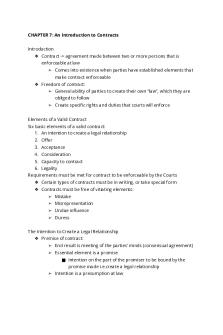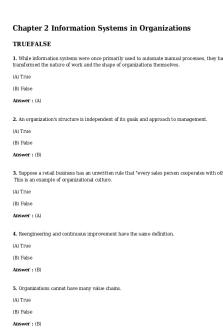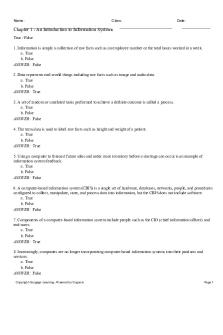Chapter 8 – An Introduction to Metabolism PDF

| Title | Chapter 8 – An Introduction to Metabolism |
|---|---|
| Course | Cell/Molecular Bio Coll |
| Institution | Duke University |
| Pages | 7 |
| File Size | 228.5 KB |
| File Type | |
| Total Downloads | 49 |
| Total Views | 154 |
Summary
Cell/Molecular Bio Coll
...
Description
BIO 1305 – Seeve/Manon
Name:_______________________________
Chapter 8 – An Introduction to Metabolism Learning Objectives 1. What is catabolic, anabolic, exergonic, endergonic? 2. Review different forms of energy. 3. Apply the first & second laws of thermodynamics to biological systems 4. How can we explain that very complex, ordered biological system spontaneously evolved from simpler systems? 5. Be able to apply: ∆G = ∆H – T∆S 6. How does free energy, entropy, and stability change for a spontaneous reaction? 7. When is ∆G its lowest for a chemical reaction 8. How is ATP involved in coupling reactions to drive cellular work (mechanical, chemical, transport) 9. How do enzymes affect chemical reactions (G? EA?) 10. How does the enzyme-substrate interaction specifically decrease Ea? 11. What are some environmental factors that influence enzyme activity? How does this relate to the evolution of some of the enzyme’s properties? 12. Be familiar with enzyme regulation: competitive, allosteric, cooperativity, feedback inhibition, location in the cell
What is catabolic, anabolic, exergonic, endergonic? Match the following terms: Catabolic -
Anabolic –
Define exergonic, then graphically illustrate a highly exergonic reaction.
Define endergonic, then graphically illustrate a highly endergonic reaction.
Review different forms of energy What is energy?
BIO 1305 – Seeve/Manon
Name:_______________________________
As described by your book, what are the four types of energy? List them and define them:
•
From the following video, indicate the types of energy at each given moment: http://www.youtube.com/watch?v=MlpsBymlWj0
Apply the first & second laws of thermodynamics to biological systems • The study of the energy transformations that occur in a collection of matter is called __________________________.
The 1st Law of Thermodynamics
The 2nd Law of Thermodynamics
How does the second law of thermodynamics help explain the diffusion of a substance across a membrane? See Fig. 7.13 on page 132.
•
What does spontaneous process mean (relative to biology)?
•
What does nonspontaneous mean (relative to biological reactions)?
BIO 1305 – Seeve/Manon
•
Name:_______________________________
How are entropy and spontaneous reactions related?
How can we explain that very complex, ordered biological system spontaneously evolved from simpler systems? Organisms are islands of ______________ ________________ in an increasingly random universe. The entropy of a particular system, such as an organism, may actually ________________ as long as the total entropy of the universe ____________________________________ - __________________. From these sentences explain the objective.
Be able to apply: ∆G = ∆H – T∆S • What does this equation calculate? Define the following symbols: • ∆ • G • H • T • S Verbally, this reads: The change in free energy is equal to the change in the system’s enthalpy minus the temperature in Kelvins multiplied by the change in the system’s entropy. • • •
If ∆G is negative, the process is _____________________. If ∆G is positive, the process is ______________________. If ∆G is zero, the process is _________________________.
Summary: Negative
Positive
∆G Determine if the process is spontaneous given the following values: ∆G = ∆H – T∆S •
∆H is negative and T∆S is negative
Zero
BIO 1305 – Seeve/Manon • •
Name:_______________________________
∆H is positive and T∆S is negative ∆H is positive and T∆S is positive
If ∆H is positive, what does that mean for the system? What if ∆S is positive?
How does free energy, entropy, and stability change for a spontaneous reaction? How does ∆G relate to stability?
What is the state of maximum stability called?
How does the following equation relate to this concept? ∆G = Gfinal state – Ginitial state
Analysis Questions • Cellular respiration uses glucose and oxygen, which have high levels of free energy, and releases CO2 and water, which have low levels of free energy. Is cellular respiration spontaneous or not? Is it exergonic or endergonic? What happens to the energy released from glucose? •
Some night-time partygoers wear glow-in-the-dark necklaces. The necklaces start glowing once they are “activated,” which usually involves snapping the necklace in a way that allows two chemicals to react and emit light in the form of chemiluminescence. Is the chemical reaction exergonic or endergonic? Explain.
How is ATP involved in coupling reactions to drive cellular work (mechanical, chemical, transport)? • How are cellular conditions more favorable for energy release, over standard conditions? •
How is the idea that ATP are high-energy phosphate bonds misleading?
•
Why is ATP a favorable molecule to use for energy release? (i.e. where does the energy come from?)
•
How does a reactant become phosphorylated? Is it more or less stable than the unphosphorylated reactant? What does this mean for the reactant in terms of driving a reaction?
•
How does ATP function in cells that need transport and mechanical work done?
BIO 1305 – Seeve/Manon •
Name:_______________________________
Which of the following combinations has more free energy: glutamic acid + ammonia + ATP, or, Glutamine + ADP + Pi ? Explain.
Free energy
How do enzymes affect chemical reactions (G? EA?)
A
A
B
C
D
B
D C Reactants
A
B G () 0
C
D
Products Progress of the reaction Graph the progress of an endergonic reaction in which EF and GH form products EG and FH, assuming that the reactants must pass through a transition state.
Illustrate (using a graph similar to the one you just drew) to show how enzyme catalyze reactions: • What is the only thing that changes? • What implications does this change have?
BIO 1305 – Seeve/Manon
Name:_______________________________
How does the enzyme-substrate interaction specifically decrease EA? • Why couldn’t you just use heat to increase the rate of all reactions? •
How are enzymes and substrates like locks and keys? How are they not like locks and keys (incorporate the idea of induced fit).
Label the following diagram:
5
What are some environmental factors that influence enzyme activity? How does this relate to the evolution of some of the enzyme’s properties? • Given that a mature lysosome has an internal pH around 4.5, draw a curve in (b) showing what you would predict for a lysosomal enzyme, labeling its optimal pH.
BIO 1305 – Seeve/Manon
•
Name:_______________________________
In nature, what conditions could lead to natural selection favoring bacteria with enzymes that could break down the fucose-containing disaccharide discussed on page 157? See the discussion of natural selection in Concept 1.2, pages 14-16.
Be familiar with enzyme regulation: competitive, allosteric, cooperativity, feedback inhibition, location in the cell • Imagine you are a pharmacological researcher who wants to design a drug that inhibits a particular enzyme. Upon reading the scientific literature, you find that the enzyme’s active site is similar to that of several other enzymes. What might be a good approach to developing your inhibitor drug?
•
Malonate is an inhibitor of the enzyme succinate dehydrogenase. How would you determine whether malonate is a competitive or noncompetitive inhibitor?...
Similar Free PDFs

An introduction to Psychology
- 4 Pages

An introduction to sociolinguistics
- 451 Pages
Popular Institutions
- Tinajero National High School - Annex
- Politeknik Caltex Riau
- Yokohama City University
- SGT University
- University of Al-Qadisiyah
- Divine Word College of Vigan
- Techniek College Rotterdam
- Universidade de Santiago
- Universiti Teknologi MARA Cawangan Johor Kampus Pasir Gudang
- Poltekkes Kemenkes Yogyakarta
- Baguio City National High School
- Colegio san marcos
- preparatoria uno
- Centro de Bachillerato Tecnológico Industrial y de Servicios No. 107
- Dalian Maritime University
- Quang Trung Secondary School
- Colegio Tecnológico en Informática
- Corporación Regional de Educación Superior
- Grupo CEDVA
- Dar Al Uloom University
- Centro de Estudios Preuniversitarios de la Universidad Nacional de Ingeniería
- 上智大学
- Aakash International School, Nuna Majara
- San Felipe Neri Catholic School
- Kang Chiao International School - New Taipei City
- Misamis Occidental National High School
- Institución Educativa Escuela Normal Juan Ladrilleros
- Kolehiyo ng Pantukan
- Batanes State College
- Instituto Continental
- Sekolah Menengah Kejuruan Kesehatan Kaltara (Tarakan)
- Colegio de La Inmaculada Concepcion - Cebu













